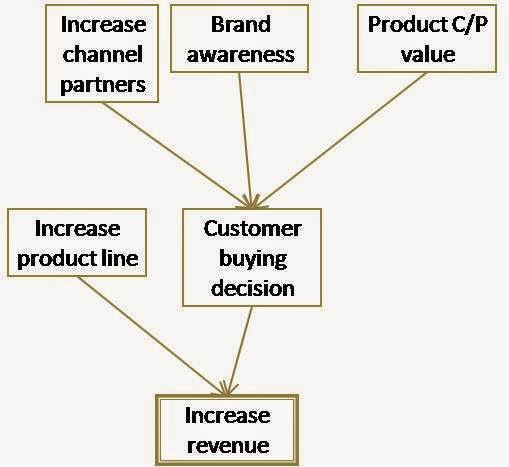~ How are you going to reach your goal? What's your strategy? ~
~ I've done so many analysis, SWOT, 5 forces, but still, I am not sure what's the strategy to use? ~
To address your questions, here I would like to propose one of the easiest/best model that always works for me. Initially the methodology is for myself, to help me to find out root cause, and how to improve it. Then I found it also help me to make the right decision for your business, sales, marketing purposes. It's has a very easy, intuitive way for you to follow and it can be applied in many situations, so I would like to share it with everyone.
Let's see how it works:
- First step, define a clear goal you want to achieve
- Find out all the factors that have impact to your goal, including 2nd, 3rd, 4th or as many level as you can image. You can also have a rough estimate on the weightings of each factors, how big impact does it have to your goal.
- Once the relationship of those factors, weightings, and goals have been built, the final step is to think about how to change those factors such that it will have positive impact to help you to reach your goal. There your strategy comes out. You can define the strategy to try to remove the factors, add more factors, increase the weighting, decrease the weighting.
Isn't that easy? A simplified concept is as below. It's common that you can't find out all the factors, but it's OK. As time goes by, I believe you can find out more and more and gradually correct this model.
Now let's use areal case example.
Step 1: define your goal. So here it is:
~ Our goal is to increase revenue. ~
Step 2: find out all the factors that have impact to your goal.
The 1st level diagram is easy. It can be as simple as below. The bottom one is the goal and the upper two are the 1st level factors that has impact to your revenue. It's quite easy to figure out that the customer buying decision will have impact to your revenue. The more they buy, the more revenue you gain. However, you can also take "increase product line" action. The more variety of product you sell, the better chance you can fulfill different customer needs. If you apply this to solution selling, increasing product line means you can offer more complete solution for customers to have a one-stop-shop.The 2nd level diagram is the extension of the 1st level. It's important to list out more factors because it quite often that you can't see your strategy if you only did a 1st level analysis. So, the 2nd level diagram can be looked like as below. Mainly we are focusing on what's affect customer's buying decision. We have product C/P value, the branding, and maybe the more channels you have, the better customer reach you get. All those will have impact to customer's buying decision.
Now we can go further more, and your picture will be clearer as below diagram.
Step 3: So how to generate your strategy? Two ways, you can try to strengthen those "positive factors" that support you to achieve your goal. You can also weaken those "negative factors" that hinder you from achieving your goal.
For example, if you want to choose to affect customer buying decision, what's the plan? From the diagram, you can easily come out some idea in your mind such as "increasing your channel partners". In order to do so, you should allocate budget to join seminars, which allows you to reach more partners. or you can provide technical training to those partners who were, originally, not familiar with your product. By doing the training, your potential partner can be more actively help you to sell your products.
Strategy is not magic that can turn things into gold over night. But if you execute it correctly, gradually the negative factors will be out and positive factors will be strengthened. Then I can guarantee what you want will definitely happen. It's just a matter of time.
Finally, can this be applied to your daily life? The answer is yes. Whatever goal you want to reach, it's all about different impact factors. Some of them may be from other people, and some of them maybe reside in yourself. For example, if you like a girl and you want she likes you back. Maybe it's hard to change what's in her mind, but you can definitely make yourself better, more adorable, or upgrading yourself, in terms of manners, hard-working, knowledge, or whatever.
Remember, a strategy is a method or a plan to help you to reach your goal. Now you have clear picture how to do the strategic planning. But don't ever forget, planning is just some paperwork. The execution is the actual key to open the door.
Follow up reading on "occasional vs destined".
Tweet




